- Introduction
- Installing and starting Dact
- Getting started
- Queries
- Converting corpora
- Configuring Dact
- Macros
- Tools
- Common problems
Introduction
Dact is an application for browsing and searching syntactically annotated treebanks such as Lassy Small and Lassy Large. This manual provides an introduction to the Dact interface and its query language. If you are already familiar with Dact and want to see a more in-depth treatment of interesting linguistic phenomena, you might be interested in the Dact Cookbook.
Installing and starting Dact
Dact for Windows, Mac OS X, and Ubuntu can be obtained via the Dact website. Here, we provide instructions for installing and starting Dact.
Windows
After downloading the Windows installer, run it. The installer will copy Dact to your Program Files directory and add a Start Menu item.
On Windows XP, Vista, and 7, you can start Dact by clicking on the Start Menu and selecting Dact from the list of programs. On Windows Vista, 7, and 8, you can press the Windows key and type dact. Dact should appear in the list of programs, where you can select it.
macOS
Dact is provided as a disk image. Click the on the disk image in your browser or double click on the disk image in Finder to open it. Then drag Dact to your Applications folder.
You can start Dact by double clicking on Dact in Finder. It’s usually faster to start Dact from Spotlight. Press Cmd + Space to open the Spotlight search popup, type dact, and press Return.
Dact can also be installed with Homebrew:
brew tap rug-compling/dact
brew install dact
Linux
No up-to-date precompiled Linux packages are available. The recommended installation method is compiling Dact from source.
Getting started
Once Dact is started, the Open Corpus dialog will pop up:
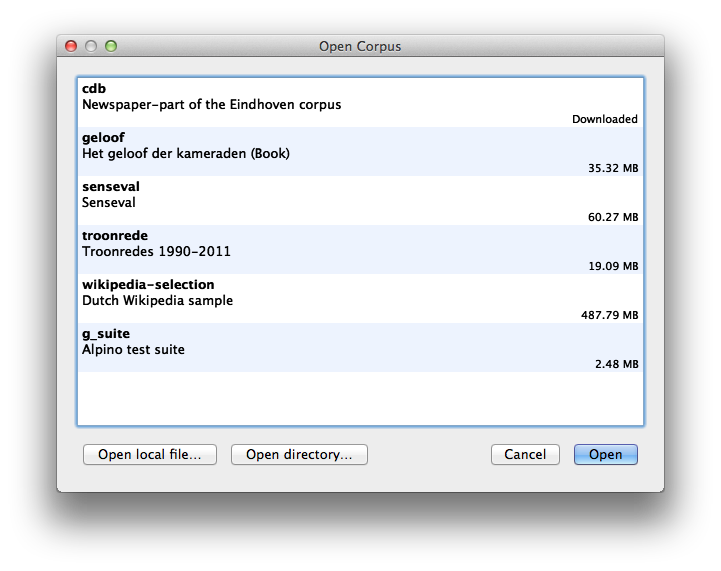
You have three options to open a corpus:
-
Opening a publicly available corpus: The dialog shows a list of corpora that are publicly available. Selecting a corpus from the list will open it. If the corpus is not available on your computer, Dact will download it for you.
-
Opening another corpus: If you have a corpus that is not publicly available, such as Lassy Small, you can open it by clicking on the Open local file button (or press Ctrl+l or *Cmd+l on a Mac) and selecting that corpus.
-
Opening a directory with corpora: You can also open a directory with corpora using the Open directory button. This is especially useful for large corpora, such as Lassy Large, which are distributed as a collection of smaller Dact corpora.
After opening a corpus, the window will resemble the following:
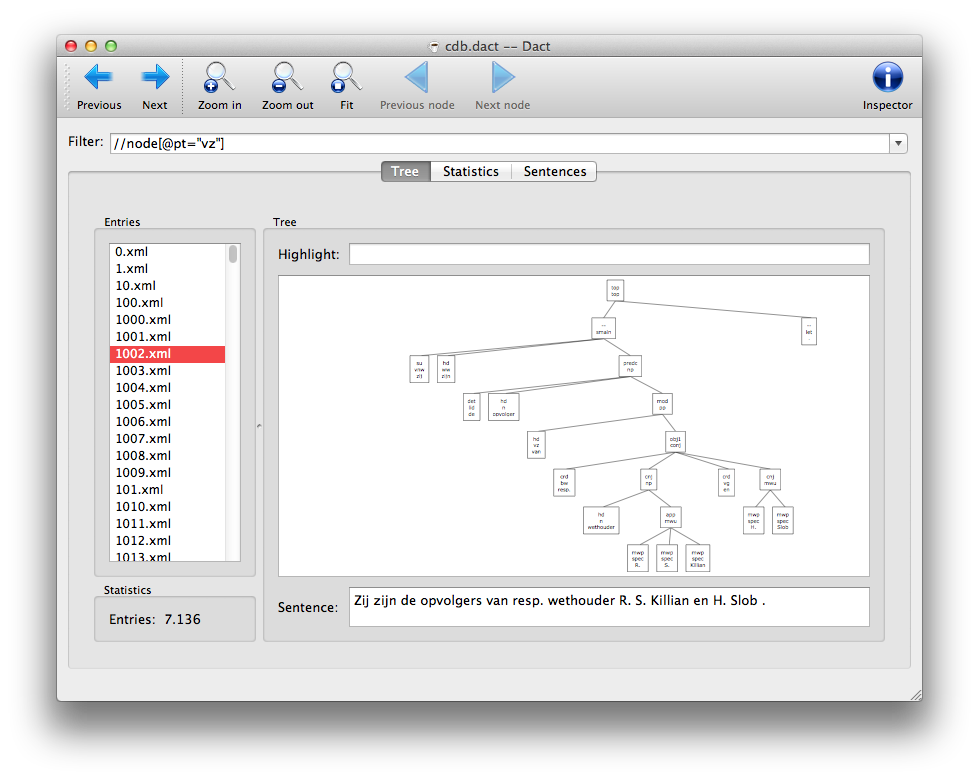
The main Dact Window consists of a filter field and three tabs:
-
The Tree tab shows all entries with matching nodes in the corpus that match your filter query. You can click on an entry to show its dependency tree. You can also open the Inspector using the button in the upper right corner (Ctrl+i) and inspect the attributes of individual nodes in the dependency tree by selecting them.
-
The Statistics tab shows the frequency of values of a specific attribute for all the nodes in the corpus that match your filter query. You can specify which attribute you want to count with the dropdown menu on this tab.
-
The Sentences tab shows the entries containing matching nodes as sentences, and highlights them.
Although the corpus can be browsed entry by entry, most functionality of Dact is query-driven. After a short introduction to the query language in the next section, you will be prepared to use other functionality of Dact.
Queries
Queries are written in the XPath query language.
Matching a node
Every node in the tree is represented as an node element. You can match any node in the tree by using two forward slashes:
//node
Of course, normally, you would want to match nodes with certain
restrictions based on the context or specific attributes of a node.
Such restrictions can be entered between square brackets ([ and ]). Attributes are
prefixed by the ‘at’ sign (@). Commonly-used attributes are:
- rel
- relation label
- cat
- category
- postag
- part of speech tag
- pt
- abbreviated part of speech tag
- lemma
- the lemma of a lexical node
- word
- the word of a lexical node
For instance, the following query will match all nodes with the postag attribute, or in other words lexical nodes:
//node[@postag]
We can also restrict the selection by requiring that an attribute has a specific value using the equals sign (=). For instance, the following query will match all nodes, which have a postag attribute with the value BW():
//node[@postag="BW()"]
Such conditions can also be combined. Using the and operator will require both conditions to be true, while the oroperator requires one of the conditions to be true. The following query will match all nodes with a mod dependency relation, that also have det as their part of speech tag:
//node[@rel="mod" and @postag="BW()"]
There are some functions available in XPath which may be useful. For
example using not we could find any node that does not match a certain
condition. Say we want to match everything except nouns, we could write:
//node[not(@pt="n")]
Or say we wanted to match everything except nouns that are lexical nodes
starting with the letter v. We can use the starts-with function to
require that the word attribute starts with the text v. The and
operator will tie them together.
//node[not(@pt) and starts-with(@word, "v")]
contains is another function that works just like starts-with, except
it matches if the pattern is contained in the value of the attribute.
We can also make queries based on the structure of a tree. For example, the following query will match any node with a su dependency relation that has an adverb: one of the children of the matching node is a node of which the postag attribute equals BW()t.
//node[@rel="su" and node[@postag="BW()"]]
Now that query matched the su node, but we can also match the adverbial node. This is useful in the Statistics Window, where the matching nodes are used to determine the frequencies. This query will do just that:
//node[@rel="su"]/node[@postag="BW()"]
It first finds the subject nodes, and then matches all the adverbs found in these nodes. Similarly, a query can be constructed which selects nouns in the noun phrase of a prepositional phrase. We first find the prepositional phrase somewhere in the tree (mind the double slash), then find the noun phrase among one of its children (the single slash), and then find a noun among the children of the noun phrase.
//node[@cat="pp"]/node[@cat="np"]/node[@pt="n"]
This goes down deeper into the tree, but we can also move back up in the tree using double dots. Say we wanted to select all the siblings of a noun node, we can use .. to move up to the parent of the noun node, and then select all the children of this parent node:
//node[@pt="n"]/../node
Or we could select all nodes with a parent node with a child node which is a noun:
//node[../node[@pt="n"]]
Note that strings, i.e. the text between quotes and attributes can be used interchangeably since an attribute has a string as a value. For example, we could identify nodes with a @lemma value that is identical to the @word value as follows:
//node[@lemma=@word]
And we are not just bound to the attributes of the current node. Say we wanted to find examples the dutch verb krijgen used in a passive form. To do this, we have to look for sentences where the subject of the sentence is also the object of the verb phrase. In the corpus this is indicated by an index attribute. This attribute contains the same value on both nodes. We can find the node which contains the verb krijgen, a subject, and a object in the verb complement which share the value for index:
//node[ node[@rel="hd" and
@root="krijg"] and
node[@rel="su"]/@index=
node[@rel="vc"]/node[@rel="obj2"]/@index
]
Note
When using the position attributes,
@beginand@end, note that XPath sees them as strings. If you want to compare them, you may want to convert them to numbers first usingnumber(). For example://node[@cat="pp" and node[@rel="hd"]/number(@begin) > node[@rel="obj1"]/number(@begin) ]
Note
Please do note that Dact expects queries that return nodes. A highlight query returning the value of an attribute will not highlight any nodes.
Exploring a corpus
The left pane on the Tree tab shows a list of corpus entries, where each entry represents a sentence containing at least one node that matched your filter query.
After typing a query, press the Enter key, and Dact will start listing entries which match the query. If you want to interrupt the query processing (e.g. because you have seen enough hits), simply press the Esc key.
The query widget keeps track of your previous queries. You can pick one of your previous queries form the history using the arrow on the right of the filter field, and adapt the query if so desired.
Using the Next and Previous arrows in the top left menu bar, you can walk through each found entry. Or you can use the Ctrl+Down and Ctrl+Up shortcuts.
Highlighting nodes
After selecting an entry, its analysis is shown in the right pane. To to spot interesting phenomena, or test a query, you can enter a separate query in the highlight field. Each node matching the highlight query will be colored:
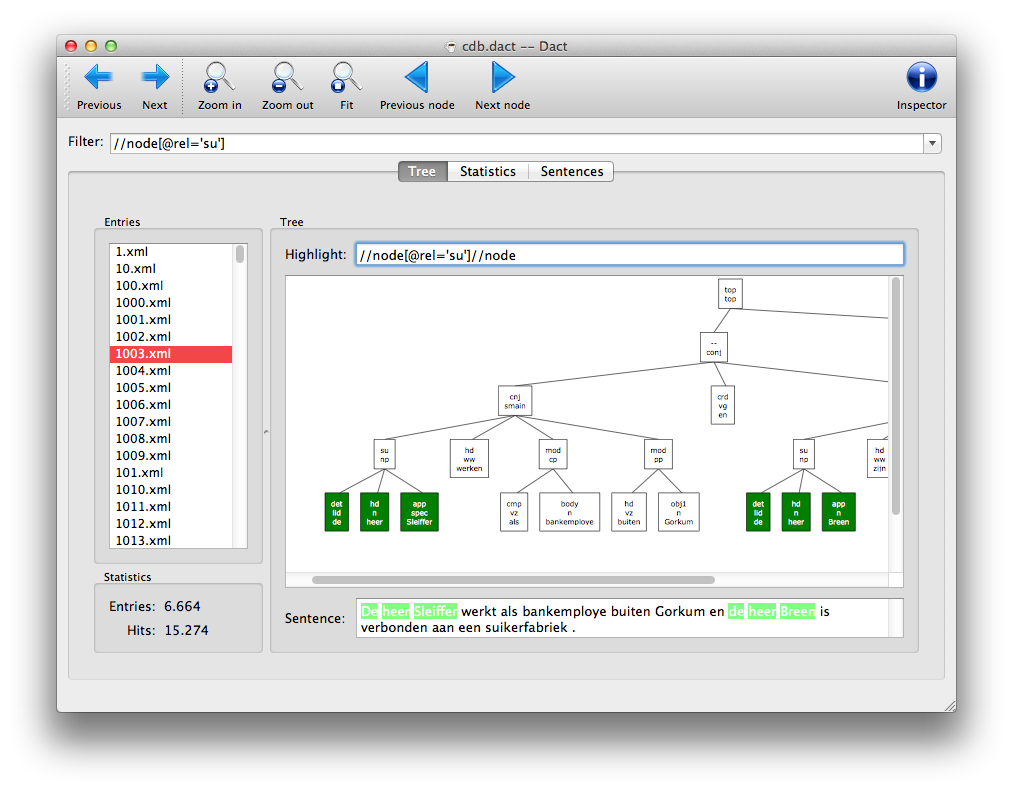
Initially, the filter query is used as the highlight query.
Matching nodes will be highlighted in the tree in green (you can alter this color in the Preferences). The buttons Zoom In and Zoom Out can be used to scale the tree. Previous Node and Next Node will guide you through all the matching nodes. You can use Ctrl+Left and Ctrl+Right as well. The node in focus will then be marked by a slightly thicker border. Normally, the scroll wheel is used for panning the tree. but when you press Ctrl, scrolling will cause the tree to scale. Ctrl+= and Ctrl+- can also be used to zoom in and out, and Ctrl+0 resets the zoom level to show the full tree, just like Fit button on the toolbar does.
The leaf nodes have tool tips showing more details about the node.
Below the tree the sentence is shown, and the parts in the sentence that are part of the matching nodes are highlighted.
Inspecting nodes
If you want to know more about a node, you can select it and open the Inspector by clicking its button on the right hand side of the toolbar, pressing Ctrl+i or by enabling it in the View menu. This is very useful for writing queries.

The Inspector will show you all attributes with the corresponding values of the node in focus. You can right-click an attribute and use the context menu to directly add it to your search query.
Tip
The Inspector is detachable and can be torn off the Main window.
Gathering statistics
The Statistics tab shows which values can be found for a certain attribute of matching nodes. If a node does match the query, but does not have the attribute, it will be counted as [missing attribute].
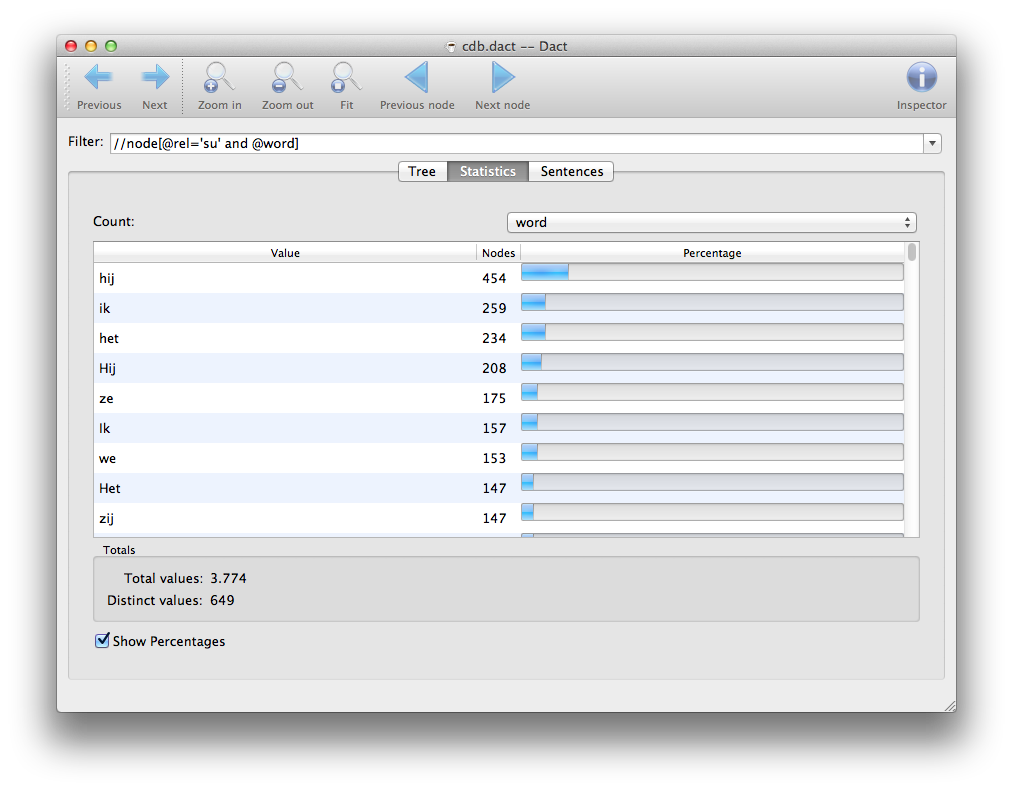
Make sure to use a query which matches the nodes you want to know the values of. For example, say we wanted to know how often every preposition occurs in a prepositional phrase. We need to filter for the preposition nodes that are children of a preposition phrase node:
//node[@cat="pp"]/node[@pt="vz"]
If you are unsure whether your filter will match too many or too few nodes, try to test it visually in the Tree tab by using your query as the highlight query.
Because we want to know how often the word occurs, we can select the word
attribute (or perhaps the lemma attribute) from the drop-down menu.
The Value column shows all the distinct values found, and the Nodes column shows how often nodes with these values where encountered. The percentage column puts this number into perspective by showing how much this is as a percentage of the total count of found values. The total is shown in the bottom right of the window, as is the number of distinct values (i.e. the number of rows in the table).
You can double-click one of the rows to search for all nodes that together are summed up in that row. Dact will automatically generate a new filter query for you.
When copying rows to the clipboards, they will be pasted as a tab-separated plain-text table. Excel and many other programs are able to import this format when pasting it into a document.
Exporting Statistics
The results from the Statistics tab can be saved in various formats: plain text, HTML, Excel worksheet and CSV. Go to the File - Save as… menu and select the file type from the drop-down menu in the save dialog.
Tip
Note that this menu item also works in the Sentences tab.
Sentences
To get an impression which parts of sentences matches a query, you can use the Sentences tab.
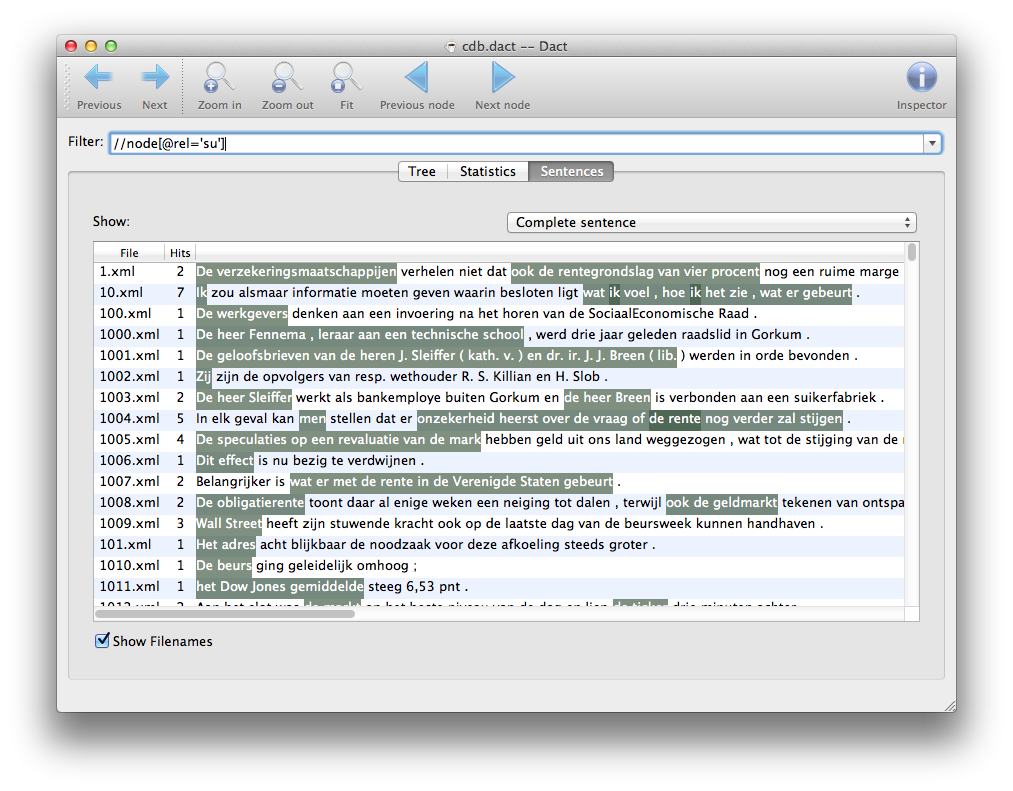
The window highlights the part of a sentence which matches the query for all the sentences in the corpus where at least one matching node is found.
You can select alternative display modes using the drop-down menu. Currently three methods are implemented:
-
Complete Sentence shows the matching nodes in the sentence on a different background. Nested matches have a more opaque background. The color can be changed in Dact’s Preference Window.
-
Only Matches shows only the words contained in the nodes that matched your query.
-
Keywords in Context shows all the matches directly underneath each other and prints the rest of the sentence left and right of the match. The colors can also be configured in Dact’s Preference Window.
Converting corpora
For many users, the functionality described in this section is not relevant.
Dact can only work with Dact corpora. However, it also provides functionality to convert a directory of XML files or a compact corpus to the Dact format. To convert such a corpus, go to the Tools - Convert corpus submenu, and choose your type. Dact will prompt you for the location of your corpus, and where to save the new Dact corpus. Afterwards you can open the newly created Dact corpus using the File - Open… menu item.
Note
Note that your original corpus won’t be affected in this process.
Converting TüBa-D/Z
TüBa-D/Z is (also) delivered in XML format (ExportXML). In contrast to Dact, this uses one XML document for the whole treebank. You can convert the ExportXML to a format usable by Dact using a Python script:
iconv -f latin1 -t utf8 tuebadz-9.0-exportXML-v2.xml > tuebadz-9.0-exportXML-v2-utf8.xml
mkdir tuebadz
cd tuebadz
python ../tdz-explode.py tuebadz-9.0-exportXML-v2-utf8.xml
You can then convert the tuebadz directory corpus as described above.
Configuring Dact
Dact has some preferences that you can change, such as the font and colors of the interface. You can find these in the Preference window, which you can find in Edit menu. (On OS X, you will find it in the application menu like any other OS X application.) Changes are automatically applied and saved.
If you accidentally mess up, you can always revert to the default preferences that Dact ships with, by clicking the Return to Default button in a tab. The preferences will be restored to their default values.
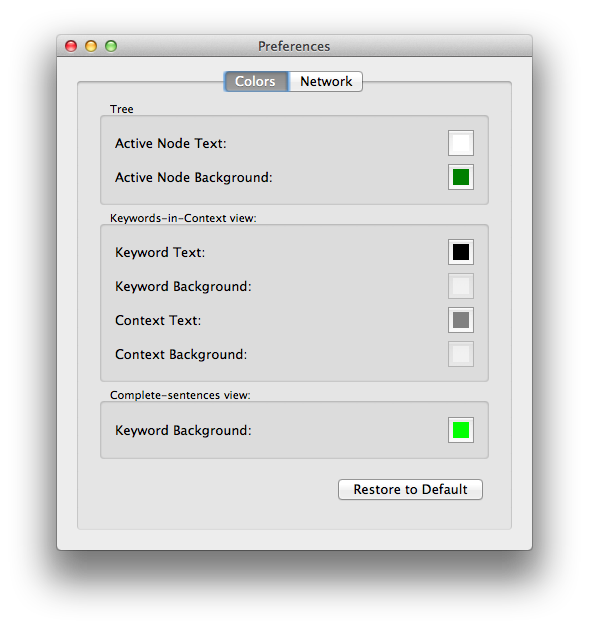
Font and colors
Dact allows you to choose your own colors and font used in the interface to some extent.
Note that the OS X version of Dact does not have a Font tab. In the other versions of Dact you can change the font that is used for the buttons and lists throughout Dact.
Network
Dact’s Download corpus, Open remote corpus and Parse sentences features use web services to function. The addresses of these web services can be changed.
Note
Note that not all of these features may be enabled in your version of Dact, as of the time of writing not all of the required web services are publicly available.
Macros
Dact supports macros in its XPath queries. You can insert simple
placeholders in your query which are expanded before a query is
evaluated. A placeholder is the name of the macro surrounded by
percentage signs (%). A set of macros can be stored in a
separate file, which you can load from Dact.
Using a macro
Given you have loaded a file with the following macro:
interesting = """ @rel="su" or @rel="vc" """
When you enter the following query in to the filter query field:
//node[%interesting%]
Dact replaces the placeholder, and executes the following query:
//node[ @rel="su" or @rel="vc" ]
Since Dact only does simple text replacement, you can also use invalid or partial XPath code as replacement. As long as the expanded query is valid, Dact will accept it.
Loading a file with Macros
You can load a file with macros with the Macros - Load file… menu item. When the file is successfully loaded, a submenu with the same name as the filename is visible in the Macros menu, containing all the macros in the file.
When you have focused one of the XPath query fields in Dact, you can select one of the macros from the Macros menu to insert it at the position of your text cursor.
Macro file syntax
Macro files are rather simple and can be created with any plain text editor. Macros have the following syntax:
placeholder = """replacement"""
placeholder is the name of your macro, and replacement the XPath
code it will be replaced with. The name and replacement are separated by
a =, and the replacement has to be surrounded by three pairs of double
quotes. replacement may span several lines.
Dact also expands macros while loading them. This way, you can use macros that were defined before in the same file.
b = """number(@begin)"""
e = """number(@end)"""
headrel = """ ( @rel="hd" or @rel="cmp" or @rel="mwp" or @rel="crd" or
@rel="rhd" or @rel="whd" or @rel="nucl" or @rel="dp") """
precedes_head_of_smain = """
( ancestor::node[@cat="smain"]/
node[@rel="hd"]/%b%
> node[%headrel%]/%b%
or
ancestor::node[@cat="smain"]/
node[@rel="hd"]/%b%
> %b% and @pos
)
"""
All lines which start with # are treated as comments.
Tools
Using tools
In both the Tree and Sentences tabs the individual files matching your filter query are shown. You can add additional entries to the context menu for these files by configuring tools. For example, you could configure a text editor to show the raw XML data of the selected sentence.
If you have selected multiple files, Dact will start the selected tool once for each file.
Configuring tools
The path to a tools configuration file can be set in the Preferences of Dact. Once the path is set, the file is loaded when you open the tools context menu. If you update the file after that, Dact will reload it automatically.
Tools configuration file syntax
The syntax of the tools configuration file looks a lot like the one used
by the macros. In addition to this, you can use %1 as placeholder for
the filename of the selected file as shown by Dact in the Tree tab. For
example, to define an “Edit Text” menu entry:
Edit Text = """gedit "~/treebanks/cdb/%1""""
Tip
In this example the complete path is surrounded by quotes, as the filename may contain spaces.
Unfortunately, the XML files Dact uses are not accessible outside of the
Dact database files. But if you have the raw XML files installed
somewhere (e.g. in ~/treebanks/cdb), you can refer to those.
Tools for a specific treebank
Because you cannot let the tools interact with the treebank, you might
need to configure your tools differently for each treebank you use. E.g.
your cdb.dact might need to use the files in ~/treebanks/cdb while
you have all your XML files for wikipedia.dact in
/net/shared/treebanks/wikipedia.
To allow you to specify a tool for just a few specific treebanks, you can add subsections to your tools configuration file with the path of the treebank files as name. Fortunately, you can use wildcards in these filenames. Only when the path of the currently loaded treebank matches this pattern, all tools in this subsection will be shown in the tools context menu.
mark = """bash -c "echo \"%1\" >> ~/marked_entries.txt" """
[*/cdb.dact]
show xml = """gedit "~/treebanks/cdb/%1""""
email name = """bash -c "echo \"%1\" | sendmail -v someone@domain" """
[*/wikipedia*.dact]
show xml = """gedit "/net/shared/treebanks/wikipedia/%1""""
Common problems
The application failed to initialize properly (0xc0000022)
If you get the error
The application failed to initialize properly (0xc0000022) it means
that something is wrong with the DLL permissions. Presumably with the
.dll files in the Dact distribution.
You can fix this problem by opening a command prompt, and cd to the directory in which the Dact files reside. Then type:
cacls *.dll /E /G BUILTIN\Users:R